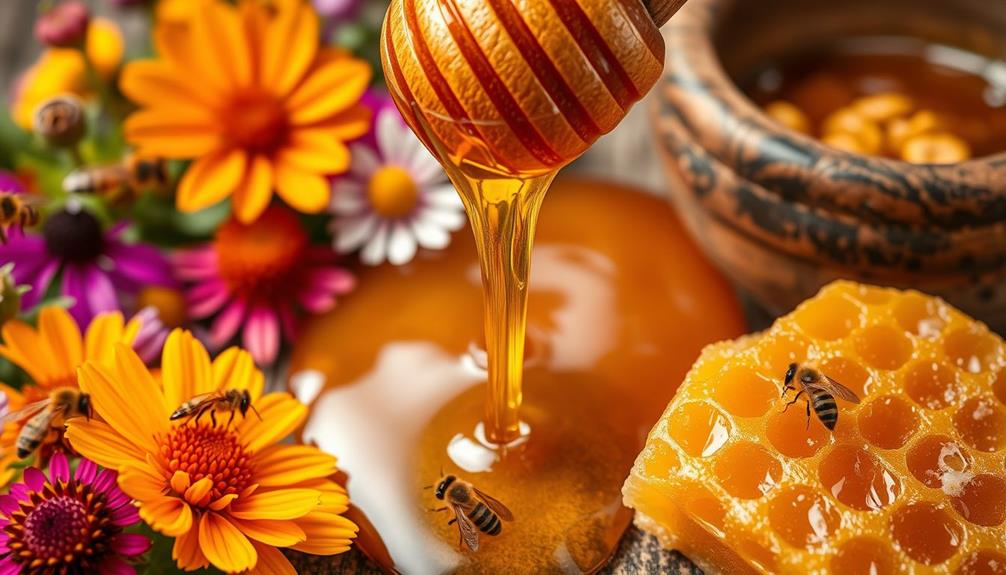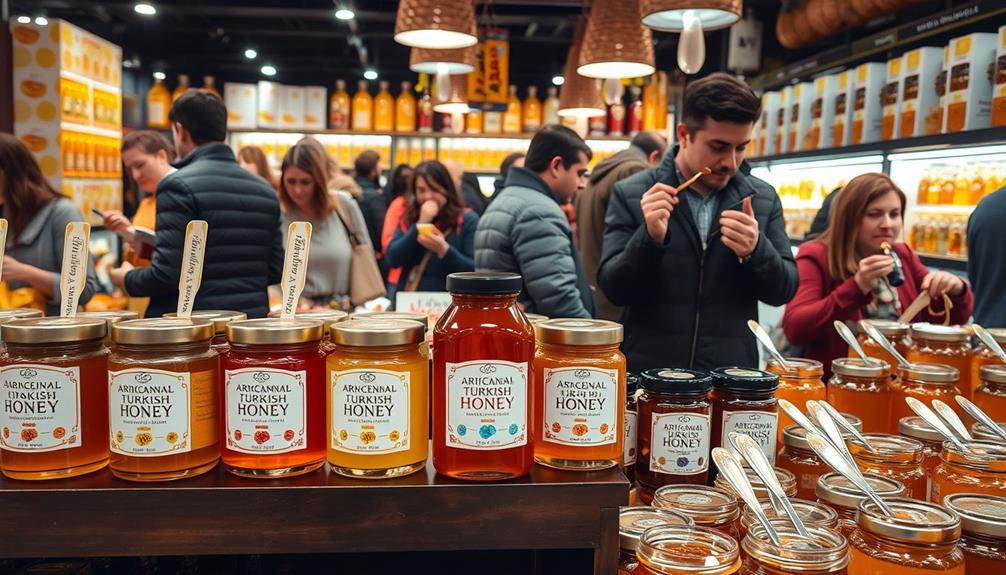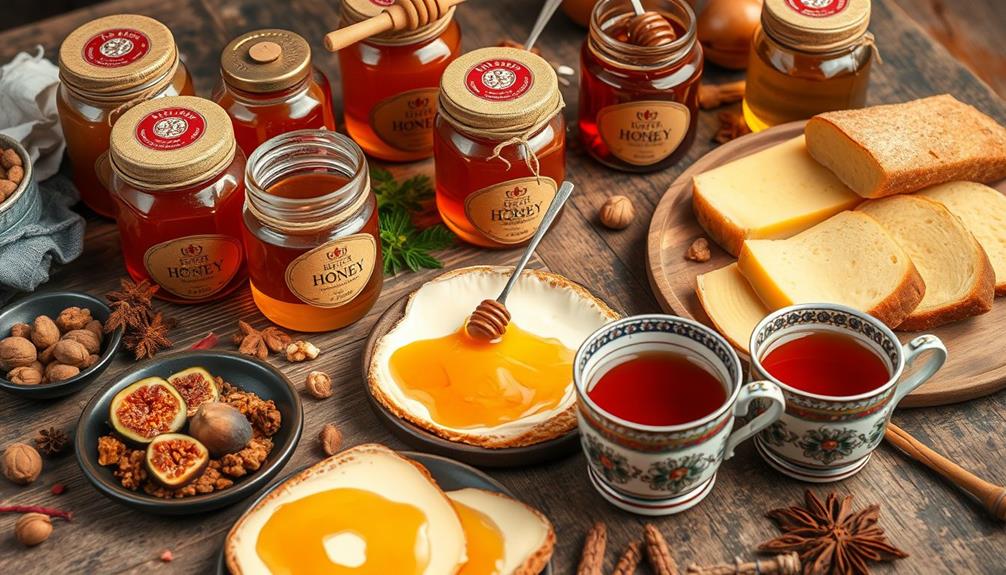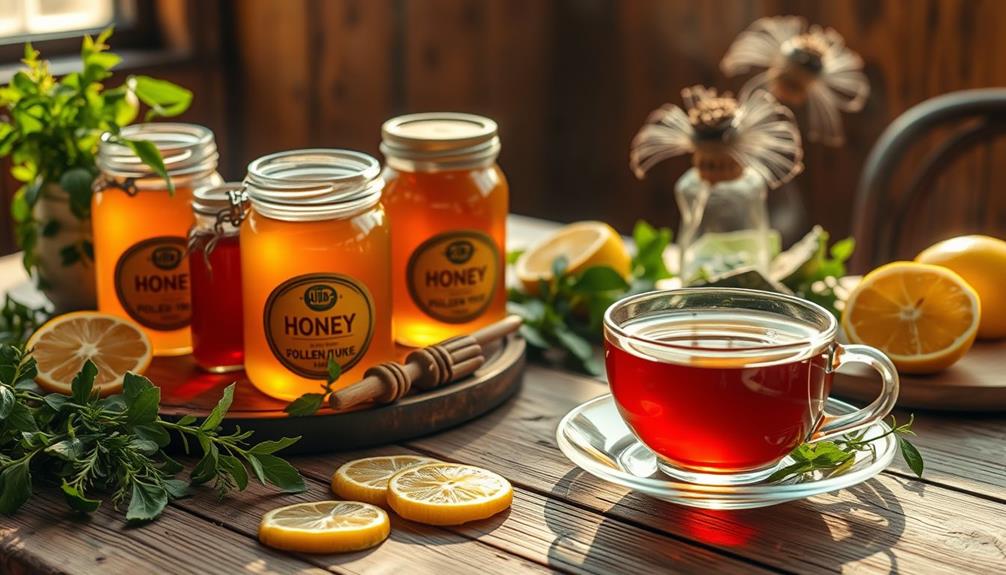Turkish honey has a fascinating history and a deep cultural significance in Turkey. It symbolizes hospitality, often welcomed by guests in homes. Emerging during the Ottoman Empire, honey is central to various traditional dishes, enhancing everyday meals and festive celebrations. You'll find it in beloved desserts like baklava and Turkish Delight, known as "Lokum," which gained international fame in the 19th century. Traditional production methods prioritize high-quality ingredients, leading to unique regional flavors. Beyond its culinary use, honey also boasts health benefits, contributing to its cherished status in Turkish culture. There's much more to uncover about this sweet delight.
Key Takeaways
- Turkish honey, recognized in the 18th century, symbolizes hospitality, often offered to guests in traditional Turkish homes.
- The term "Lokum," meaning "soothing of the throat," gained popularity in the 19th century, especially in the confectionery market.
- Honey is integral to Turkish cuisine, featured in sweets like baklava and celebrated in poetry and folklore for its sweetness and healing properties.
- Traditional production methods focus on high-quality ingredients, with regional variations enhancing flavor and texture in Turkish honey and Lokum.
- Honey possesses various health benefits, including antiseptic properties and soothing effects on sore throats, making it a valued ingredient in Turkish culture.
Origins of Turkish Honey

Turkish honey, often referred to as Lokum, has a rich history that dates back to the 18th century in the Ottoman Empire. It emerged as a symbol of hospitality and cultural identity, cherished for its sweet, comforting nature.
The term "Lokum" is believed to come from the Arabic phrase "rahat-ul hulkum," which means "soothing of the throat." This connection highlights how the delicacy was designed to bring pleasure and relief. The unique aroma and texture of Turkish honey can evoke sensory experiences similar to those found in coffee culture, where the brewing methods considerably affect the final product's characteristics. As observed in the coffee brewing techniques, understanding these nuances can deepen appreciation for various culinary delights.
As the 19th century rolled in, Turkish honey gained international recognition, particularly within the burgeoning confectionery market. The rise of chocolate around the same time helped propel its popularity, especially in Europe.
In England, Turkish Delight became a favorite, affectionately referred to as "lumps of joy." Charles Dickens even highlighted it in his writings in 1870, showcasing its impact on popular culture.
While many in Europe attempted to replicate this delightful treat, traditional versions of Turkish honey remain unique. They stand apart primarily due to specific ingredient differences, particularly the use of starch instead of gelatin.
This authenticity guarantees that Turkish honey retains its distinct charm and continues to delight with every bite.
Cultural Importance in Turkey

Cultural Importance in Turkey
In Turkey, honey holds immense cultural significance, often viewed as a symbol of hospitality and warmth. When you enter a Turkish home, it's common to be greeted with a sweet offering of honey, reflecting the country's deep-rooted tradition of welcoming guests.
The Turkish word for honey, "bal," encompasses more than just sweetness; it evokes beauty and kindness in language and literature, showcasing its broader cultural implications. Additionally, honey's role in traditional practices aligns with concepts such as music therapy integration, where natural elements are used to enhance emotional well-being and mindfulness.
Honey is also a staple in traditional Turkish cuisine. You'll find it used in delightful desserts like baklava and Bezdirme, highlighting its role as a natural sweetener in historical recipes. This culinary integration emphasizes how integral honey is to various layers of Turkish food culture.
Moreover, honey appears frequently in Turkish poetry and folklore, celebrated for its sweetness and perceived healing properties. The reverence for bees and honey is further reinforced by Islamic culture, where honey is mentioned in the Quran for its medicinal benefits.
This spiritual context adds another layer to honey's importance, making it not just a food item but a symbol of health and well-being in Turkey.
Traditional Production Methods

When you think about traditional Turkish honey, consider the meticulous heating and mixing process that goes into creating its unique texture.
Many producers enhance the flavor with regional ingredients, adapting recipes to reflect local tastes and health trends. This blend of skill and creativity not only shapes the honey but also connects generations through cherished family traditions.
Additionally, the use of honey from stingless bees can introduce unique flavors that reflect the diverse ecosystems of Turkey, further enriching the cultural significance of honey production in the region.
Heating and Mixing Process
Traditionally, the heating and mixing process for honey is a meticulous art that demands precision and care.
You'll start by heating a blend of sugar, glucose syrup, and water to a precise temperature of 140 degrees Celsius. This step is essential, as it creates the syrupy consistency that defines quality Turkish honey.
Once it's warmed, you mix in pasteurized egg white, which acts as a binding agent, giving the honey that delightful chewy texture you crave.
As the mixture cools, you'll add roasted hazelnuts. This not only enhances the flavor but also adds a satisfying crunch, ensuring the confection maintains its integrity.
Throughout the entire process, careful temperature management is critical. You want to prevent undesired crystallization, which can ruin the smoothness of your final product.
- Maintaining the right temperature prevents crystallization.
- Mixing in egg whites contributes to a chewy texture.
- Roasted hazelnuts enhance both flavor and texture.
When done right, you're left with a rich and flavorful Turkish honey, typically packed in 30-kilo portions for sale at autumn markets, showcasing the dedication behind this traditional craft.
Flavor Enhancements and Variations
The rich flavors of traditional Turkish honey, or Lokum, often come alive through various enhancements that reflect both regional tastes and personal preferences. You might discover that flavors like rosewater and lemon juice are commonly added, giving the honey a unique twist.
The basic production method starts with boiling a mixture of sugar, water, and starch, creating a syrupy consistency that serves as the perfect base for these enhancements.
As you explore different variations of Lokum, you'll notice ingredients like pistachios and coconut, showcasing the creativity and diversity across regions. Each region takes pride in its distinct flavors, often infused with local nuts or fruits.
The production process emphasizes achieving a soft, chewy texture, which hinges on the careful selection of high-quality ingredients. Traditional recipes have been passed down through generations, and as you taste, you may even detect unique family secrets that elevate the experience.
These enhancements not only contribute to the flavor but also deepen the cultural heritage tied to Turkish honey, making each bite a delightful journey through tradition and creativity.
Ingredients and Composition

At its core, Turkish honey, often referred to as Lokum, consists of a few simple yet essential ingredients that create its unique texture and flavor. The primary components include sugar, glucose syrup, water, and egg white, with optional additions like honey and roasted hazelnuts to enhance taste and texture.
- Approximately 80% of Lokum is sugar, making it a sweet indulgence.
- Egg white acts as a binding agent, giving Lokum its characteristic chewy consistency.
- Flavorings such as rosewater, lemon juice, or various nuts can reflect regional variations and personal tastes.
The production process involves careful temperature control to avoid crystallization. This attention to detail results in a sticky, soft confection that's cut into small pieces and often dusted with powdered sugar or coconut flakes.
While Lokum is known for its high sugar content, it's made from natural ingredients, making it a guilt-free sweet treat without added fats. Each bite offers a delightful experience, showcasing the artistry and tradition behind this beloved Turkish confection.
Whether enjoyed plain or with added flavors, Lokum remains a cherished part of Turkish culinary heritage.
Historical Evolution of Sweets

Sweets have played a vital role in Turkish culture for centuries, with their origins tracing back to the 15th century when they were first crafted for the Sultan's palace. These confections symbolized Turkish hospitality, showcasing the artistry and sophistication of the Ottoman court.
Over time, the tradition of sweets evolved, particularly during the 19th century, when Turkish Delight gained immense popularity in Europe, coinciding with the rise of chocolate.
Haci Bekir, a key figure in this evolution, began exporting Turkish Delight to France and England, leading to its recognition as a "lump of joy" in English literature. This marked a significant moment, as Turkish sweets began to capture the hearts and palates of people beyond their homeland.
The introduction of sugar to the Ottoman Empire in the 8th century catalyzed the development of various confections, leading to unique creations like nougat and fondant.
Regional variations and personal recipes emerged, reflecting local cultures and flavors while preserving traditional preparation methods. Through centuries of adaptation and creativity, Turkish sweets continue to be a cherished part of the culinary landscape, connecting generations and celebrating rich cultural heritage.
Modern Variations and Trends

As you explore modern variations of Turkish honey, you'll notice exciting flavor innovations that incorporate ingredients like rosewater and pistachios.
Many producers are also responding to health trends by creating less sugary alternatives without sacrificing that traditional chewy texture.
This evolution keeps the essence of Turkish honey alive while appealing to today's health-conscious consumers.
Contemporary Flavor Innovations
Innovation in flavor has breathed new life into contemporary Turkish honey, transforming traditional recipes into exciting culinary experiences. Producers are now experimenting with exotic ingredients like pistachios, coconut, and rosewater, resulting in unique variations that appeal to adventurous palates.
This creative approach showcases the versatility of honey while honoring its rich heritage.
Here are some key trends in contemporary Turkish honey:
- Artisanal Craftsmanship: Many producers focus on high-quality ingredients and traditional methods, gaining popularity in local markets.
- Regional Flavors: Modern variations often reflect local tastes, incorporating native ingredients that celebrate cultural diversity.
- Culinary Fusion: Innovative pairings with spices and fruits create unexpected flavor profiles, perfect for gourmet recipes.
As consumers increasingly seek natural foods, the resurgence of Turkish honey aligns with this wellness trend.
You'll find options that emphasize simplicity and authenticity, often without added sugars or fats.
These innovations not only enhance the flavor experience but also promote a deeper connection to Turkish culture and culinary traditions, making each jar a delightful exploration of taste.
Health-Conscious Alternatives
Many people are discovering health-conscious alternatives in Turkish honey that cater to modern dietary preferences. Modern producers are creatively reducing sugar content and using alternative sweeteners, making it easier for you to enjoy this traditional delicacy without compromising your health goals.
You'll find exciting variations that incorporate superfoods like chia seeds and matcha, boosting the nutritional profile while preserving authentic flavors.
As the clean eating trend grows, many brands are emphasizing organic ingredients and sustainable practices, appealing to your desire for environmentally responsible choices. You can now indulge in sugar-free or reduced-calorie versions of Turkish honey, allowing those with dietary restrictions to savor this beloved treat guilt-free.
Additionally, the use of natural flavorings such as fruit extracts and herbal infusions reflects a rising demand for innovative, health-oriented confections. These modern twists not only enhance the taste but also align with your wellness aspirations.
Culinary Uses and Pairings

Turkish honey, often enjoyed with tea or coffee, enhances your experience with its natural sweetness. This delightful ingredient isn't just for beverages; it plays a significant role in various culinary applications.
For instance, it's a staple during festive occasions, adding a touch of sweetness to weddings, birthdays, and religious holidays.
When it comes to desserts, Turkish honey shines in dishes like baklava, where it complements the rich flavors of nuts and phyllo dough. You can also create a delicious dessert by pairing it with yogurt. This combination balances the tartness of yogurt with the honey's sweetness, making for a healthful treat.
Here are some tasty pairings to contemplate:
- Yogurt: A perfect match that creates a creamy, sweet dessert.
- Baklava: Adds depth and richness to this classic pastry.
- Lokum: Enjoy it on its own or as a chewy accompaniment to other Middle Eastern dishes.
With its versatility, Turkish honey enriches your culinary experiences, proving to be an essential ingredient in both traditional and modern recipes.
Health Benefits and Remedies

Honey offers a wealth of health benefits, making it a valuable addition to your diet. Its antiseptic properties help treat wounds and prevent infections, thanks to its natural preservative qualities. Historically, honey has been recognized for soothing sore throats and aiding digestion, as noted by Hippocrates in the 4th century BC. Certain honey types, especially those from specific flowers, boast unique medicinal properties, like pine honey, which is revered in local traditions.
Moreover, honey enhances skin health, often featuring in natural remedies and beauty treatments for its moisturizing and antibacterial effects. However, be cautious with honey sourced from toxic flowers, such as rhododendrons. Consuming such honey can lead to "mad honey" poisoning, resulting in severe health issues.
Here's a quick overview of honey's health benefits:
| Health Benefits | Description |
|---|---|
| Antiseptic Qualities | Treats wounds and prevents infections |
| Soothes Sore Throats | Provides relief from throat irritation |
| Aids Digestion | Supports digestive health |
| Skin Health | Moisturizes and has antibacterial properties |
| Caution with Toxic Honey | Avoid honey from toxic flowers to prevent poisoning |
Frequently Asked Questions
Where Does Turkish Honey Come From?
Turkish honey comes from diverse flora across Turkey, where bees collect nectar. It's produced in regions rich in natural resources, contributing to its unique flavors and health benefits, making it a cherished product in Turkish culture.
What Kind of Honey Is There in Turkey?
In Turkey, you'll find diverse honey types like pine, thyme, and chestnut. Each variety offers unique flavors and health benefits, reflecting the local flora and traditional beekeeping practices throughout the country's rich landscapes.
Is Turkish Honey Nougat?
You might think Turkish honey is nougat, but it's not. Turkish honey, or Lokum, is chewy and made with starch, while nougat combines sugar, nuts, and egg whites, resulting in a firmer texture.
Conclusion
In Turkey, honey isn't just a sweet treat; it's a cultural treasure. Did you know that Turkey is among the top five honey-producing countries globally, yielding around 100,000 tons each year? This rich history and significance highlight how deeply intertwined honey is with Turkish traditions and daily life. As you explore its diverse uses and health benefits, remember that each jar of Turkish honey carries centuries of heritage, flavor, and wellness waiting to be discovered.










